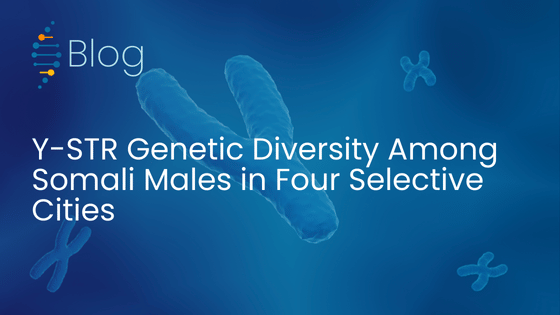In a country where forensic science is still developing, Amal Abshir Mohamed, Head of Education & Training at the Bureau of Forensic Science (BoFS) in Somalia, is breaking new ground. Her recent research on Y-chromosome short tandem repeat (Y-STR) genetic diversity among Somali males aims to enhance forensic DNA capabilities, particularly in addressing gender-based violence. Conducted across four key cities—Mogadishu, Garowe, Bosaso, and Galkayo—her study offers critical insights into population genetics and its application in forensic investigations throughout Somalia.

Briefly describe your work/area of interest.
The study examines the Y-chromosome short tandem repeat (Y-STR) genetic variation in Somali males across four cities: Mogadishu, Garowe, Bosaso, and Galkayo. The study was done at the Bureau of Forensic Science (BoFS) in Garowe, Somalia. Thus far, this is the only autonomous state government forensic science institution which also serves the whole of Somalia – particularly the area of DNA typing. The study was undertaken in response to Somalia’s increasing demand for scientific proof to address sexual assault situations.
The research was conducted by Amal Abshir Mohamed, Head of Education & Training at BoFS under the supervision of Dr. Abdirashid Mohamed Shire, Chancellor & Chief Scientific Officer of BoFS.
The study involved the collection and analyses of Y-STR genetic profiles from male suspects throughout the four cities in Somalia: Mogadishu, Garowe, Bosaso, and Galkayo. DNA extraction and amplification were performed utilizing PrepFiler™️ Forensic DNA Extraction Kit and the Yfiler®️ Plus PCR Amplification Kit, followed by analysis by capillary electrophoresis (3500 Genetic Analyzer) and GeneMapper ID-X software. Essential genetic diversity metrics, including gene diversity (GD) and haplotype diversity (HD), were calculated.
Substantial variations were observed in the genetic diversity of the male population among the four cities. The study demonstrated significant homogeneity in several markers, implying a shared ancestry, whereas others reflected increased genetic diversity. These findings provide forensic investigators with significant Y-STR profiles to refine investigation leads and elucidate the population genetics of Somalia, presumably linked to past migration and societal dynamics.
How did you become interested in this work? Why did this particular project appeal?
The necessity to implement a forensic system to assist in resolving sexual assault cases in Somalia was a significant impetus. The objective was to offer scientific backing to guarantee justice for survivors of gender-based abuse, a critical concern in a nation with constrained forensic resources. This project provided a chance to enhance the legal system through the implementation of modern DNA profiling tools.
What has been the most rewarding part of working on this project?
The most rewarding aspect has been witnessing the tangible impact of DNA evidence in solving sexual assault cases, enabling justice for survivors. Furthermore, contributing to the understanding of Somali population genetics has also been fulfilling.
Are there any further areas of research you think are needed based on your findings?
Indeed, additional study utilizing a bigger sample size and a more extensive range of markers is essential. Extending the research to encompass a wider array of Somali populations would yield a more comprehensive understanding of the nation’s Y-chromosome variety.
How do you hope your research will be applied in real-world scenarios?
This research’s findings can improve forensic investigations by providing more accurate leads through Y-STR profiling, particularly in sexual assault instances. Furthermore, it can enhance the forensic framework of the entire country, resulting in more informed judicial proceedings.

